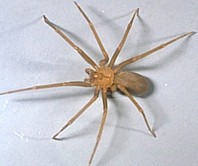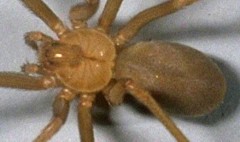|
|
ARTHROPODS:
Insects»
Spiders»
Centipedes»
Millipedes»
Sowbugs»
Harvestmen»
Mites
& Ticks»
Scorpions»
Identification
Tips»
About
the Critter Files»
Links» |
|
|
|
 |
BROWN
RECLUSE SPIDERS
Critter
Files/Spiders/Brown Recluse Spiders
By Blake Newton
University of Kentucky Department of Entomology |
Photo
courtesy Jim Kalisch Department of Entomology
University of Nebraska-Lincoln |
| |
|
| The Brown
Recluse, Loxosceles reclusa, is the only member
of the brown spider family (Loxoscelidae) that lives in Kentucky.
It is a tan, long-legged spider with a dark pattern on the
cephalothorax that resembles a violin or a fiddle. The brown
recluse makes a web that appears messy and dense. Brown recluses
usually build their webs close to the ground or floor or against
the side of a wall in underground or secluded locations. All
spiders in this family, including the brown recluse, have only 6
eyes. Like all spiders, the brown recluse has 8 legs and 2
body parts (cephalothorax and abdomen). |
| |
 Brown Recluse
(R. Bessin, 2000)
Brown Recluse
(R. Bessin, 2000) |
 Brown Recluse:
roll your mouse over the image to highlight the "fiddle"
or "violin" shape (R. Bessin, 2000)
Brown Recluse:
roll your mouse over the image to highlight the "fiddle"
or "violin" shape (R. Bessin, 2000) |
|
| SIZE:
Body length of adult brown recluse about 1/2" |
| |
| LIFE
CYCLE |
|
Simple
metamorphosis: like all spiders, young brown spiders hatch from
eggs and look like tiny adults. They shed their skin as they
grow. Females can lay dozens of eggs at once, which she wraps
in webbing and attaches to a surface for protection. |
| ECOLOGY |
|
| |
Brown recluse spiders
prefer dark secluded areas. They are common indoors, and can
live all year long in homes, barns, sheds, warehouses, and greenhouses.
They are found in protected outdoor areas as well. Brown
recluses tend to hide during the day and hunt for insects (including
crickets, cockroaches, and other common indoor insects), spiders,
and other creatures at night. Females can lay many eggs at
once, and the eggs can hatch in a few weeks. |
| |
| PEST
STATUS |
|
The brown
recluse spider is one of the most feared animals in Kentucky. Their
venom is believed to be potent, and in some regions the spiders
are very common in homes. However, because brown recluses
are so reclusive, encounters are very rare even when the spiders
are present. Also, new research
suggests that many wounds not caused by spiders are commonly
misdiagnosed as brown recluse bites.
Read more about the brown
recluse spider and its bite in:
ENTfact 631 - Brown Recluse Spider
|
| |
| COLLECTING |
|
Because of this spider's
potentially dangerous bite, you should never try to pick up or collect
a brown recluse. |
| |
| BROWN
RECLUSE FACTS |
|
Brown
recluses and black widow spiders
are probably the two most notorious spiders in Kentucky, but they
are not very closely related. The black widow spider is in
an entirely different family, the cobweb
spiders (Theridiidae).
Other spider species
are commonly mistaken for the brown recluse. The yellow-sac-spider
(Family Cheiracanthiidae), shown below, is commonly found indoors and
resembles the brown recluse except that it is lighter in color and
has no fiddle-shaped marking. It has been reported in the
past that a bite from a yellow-sac-spider may be similar to the
bite of a brown recluse, but recent medical
research suggests that the yellow sac spider is harmless. Wolf
spiders, cellar spiders,
grass spiders, jumping
spiders, cobweb spiders,
and fishing spiders are also
commonly mistaken for brown recluses. None of these spiders are
believed to be dangerous. |
| |
 Yellow Sac Spider
(R. Bessin, 2002)
Yellow Sac Spider
(R. Bessin, 2002) |
| |
Although the brown
recluse is the only spider in the Loxoscelidae family that lives
in Kentucky, there are other species that occur in the United States.
The "Chilean Recluse" resembles a large brown recluse.
It lives in the western United States. The "Mediterranean
Recluse" is similar in size to the brown recluse, and it is
found in the extreme southern United States. Like the brown
recluse, these spiders are sometimes feared but the effects of their
bites are not well understood. |
| |
| MYTHS
- LEGENDS - FOLKLORE |
|
Spider researchers
are learning more and more about the brown recluse. Recent
studies suggest that the brown recluse's bad reputation is more
myth than fact. Rick Vetter, a brown recluse expert from the
University of California, maintains a website on this topic at:
http://spiders.ucr.edu/ |
Original document: 25 May 2004
Last updated: 4 Feb 2008
Close-up brown recluse
photo courtesy Jim Kalisch, Department of Entomology, Univeristy of Nebraska-Lincoln.
Other photos courtesy R. Bessin and B. Newton, University of Kentucky
The Kentucky Critter Files are maintained by Blake Newton, Department
of Entomology, University of Kentucky.
Contact: blaken@uky.edu |
|

